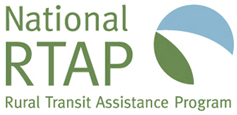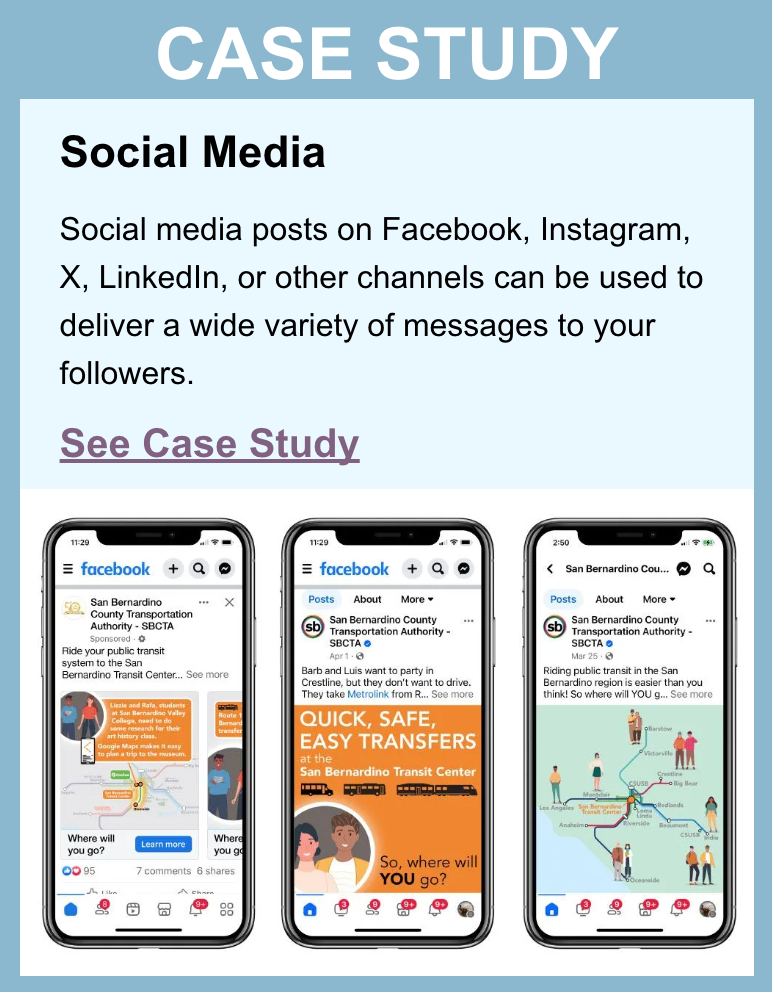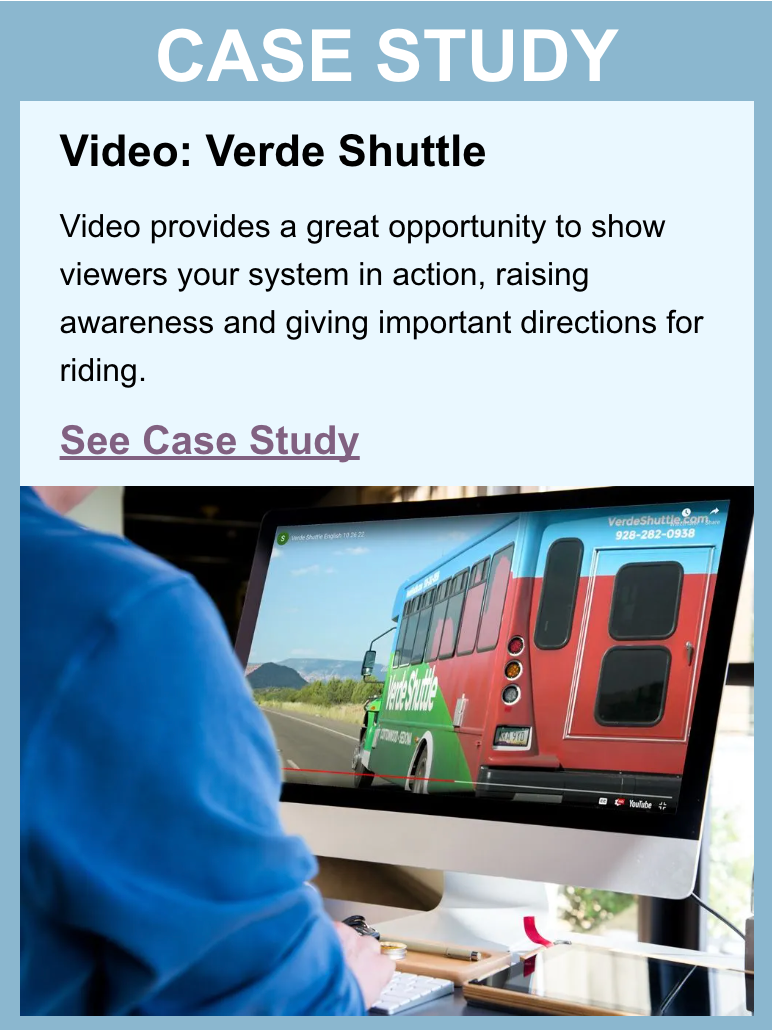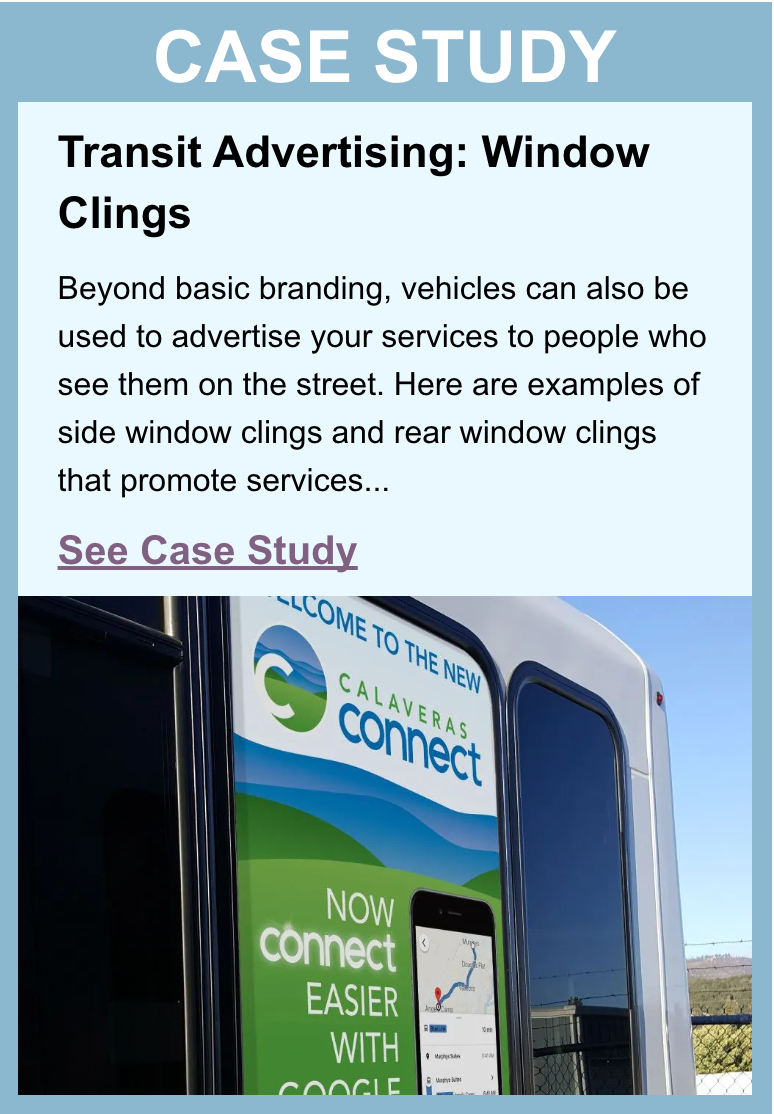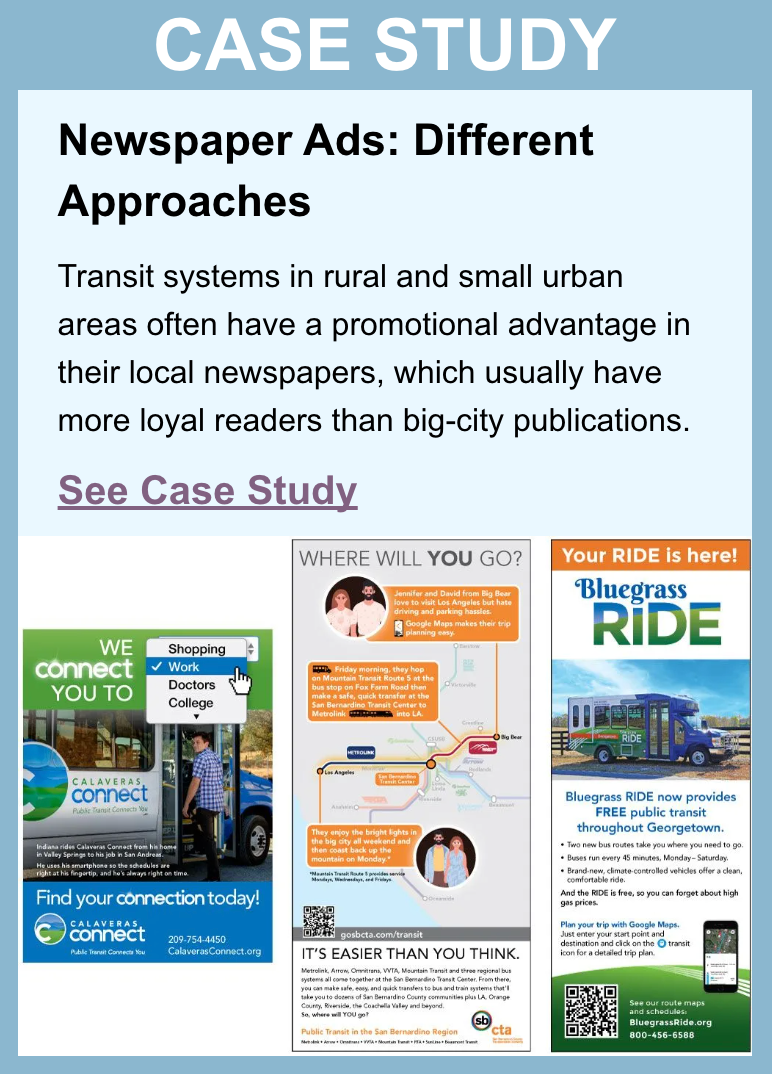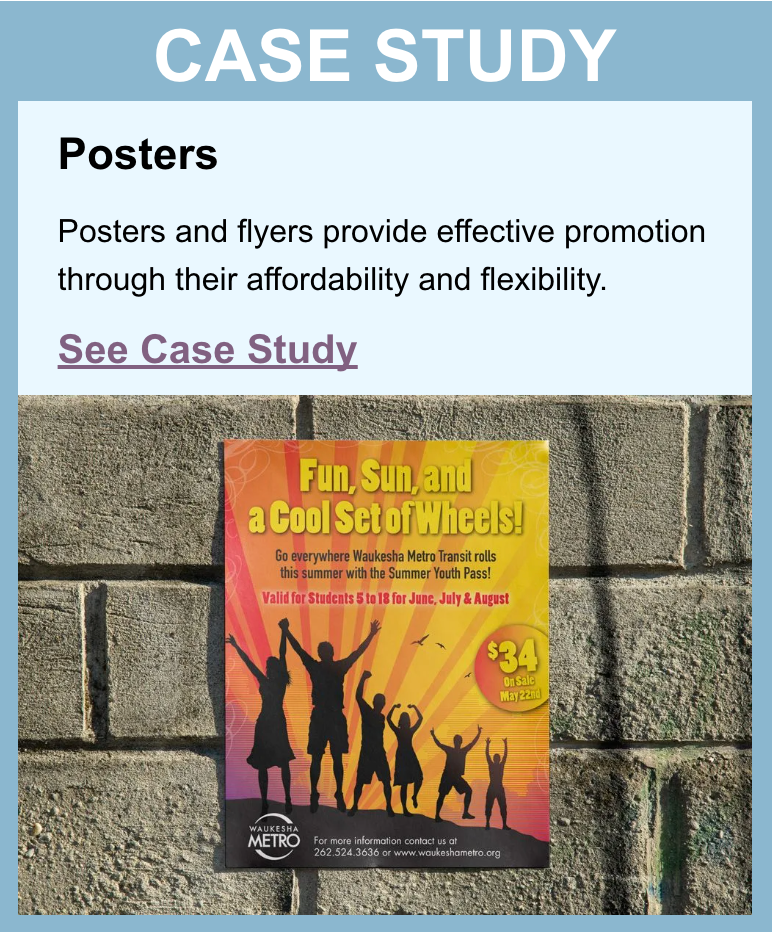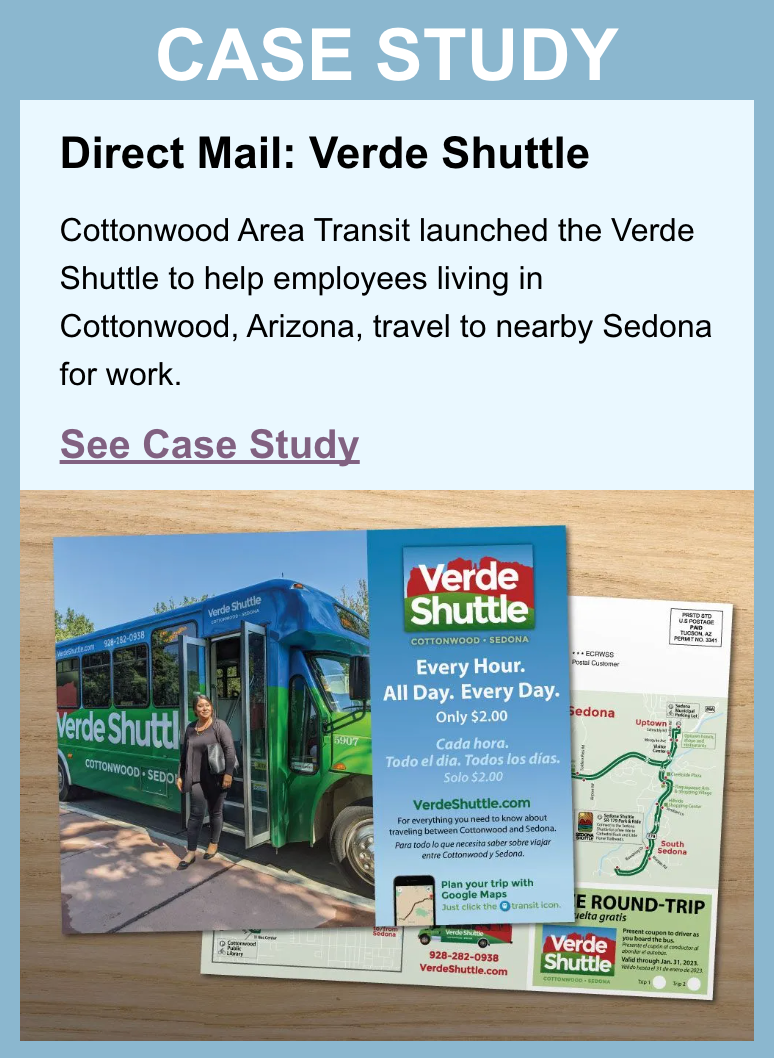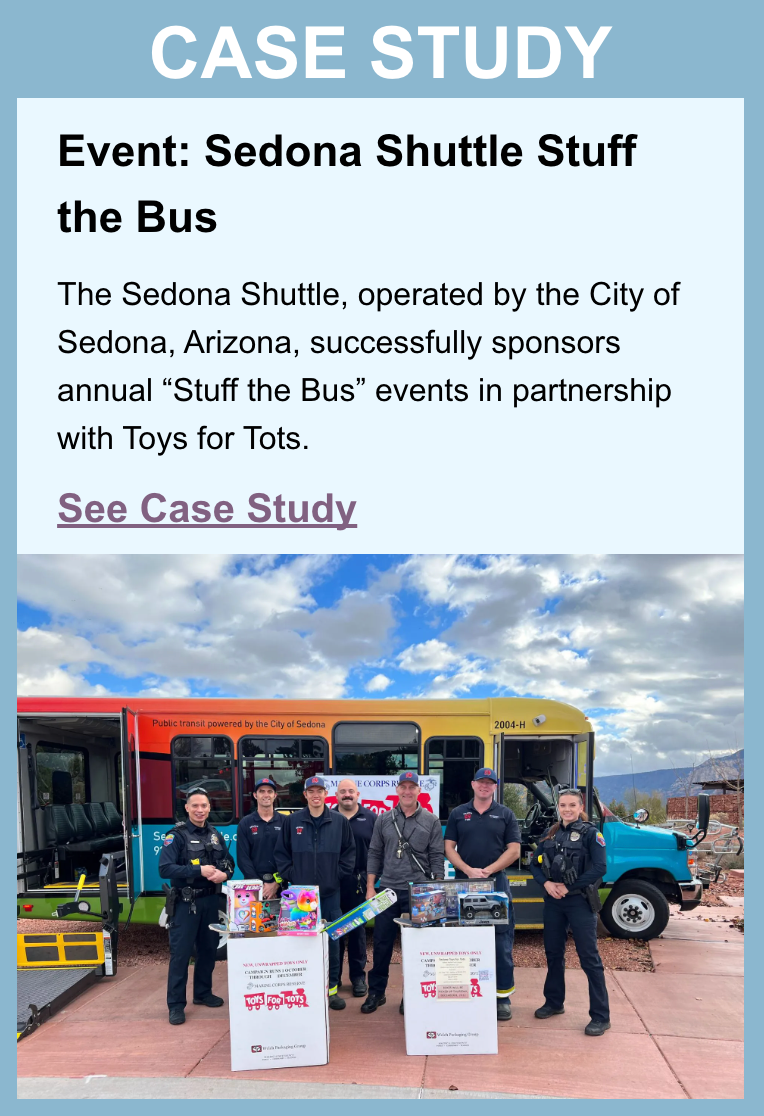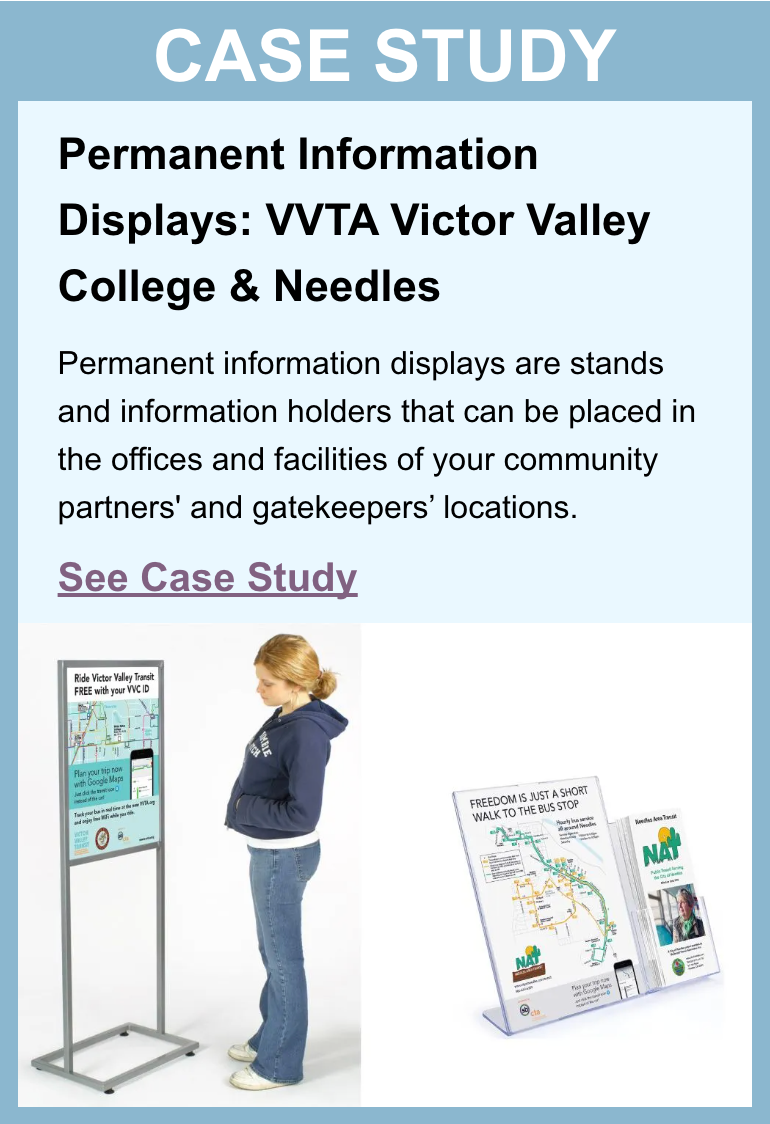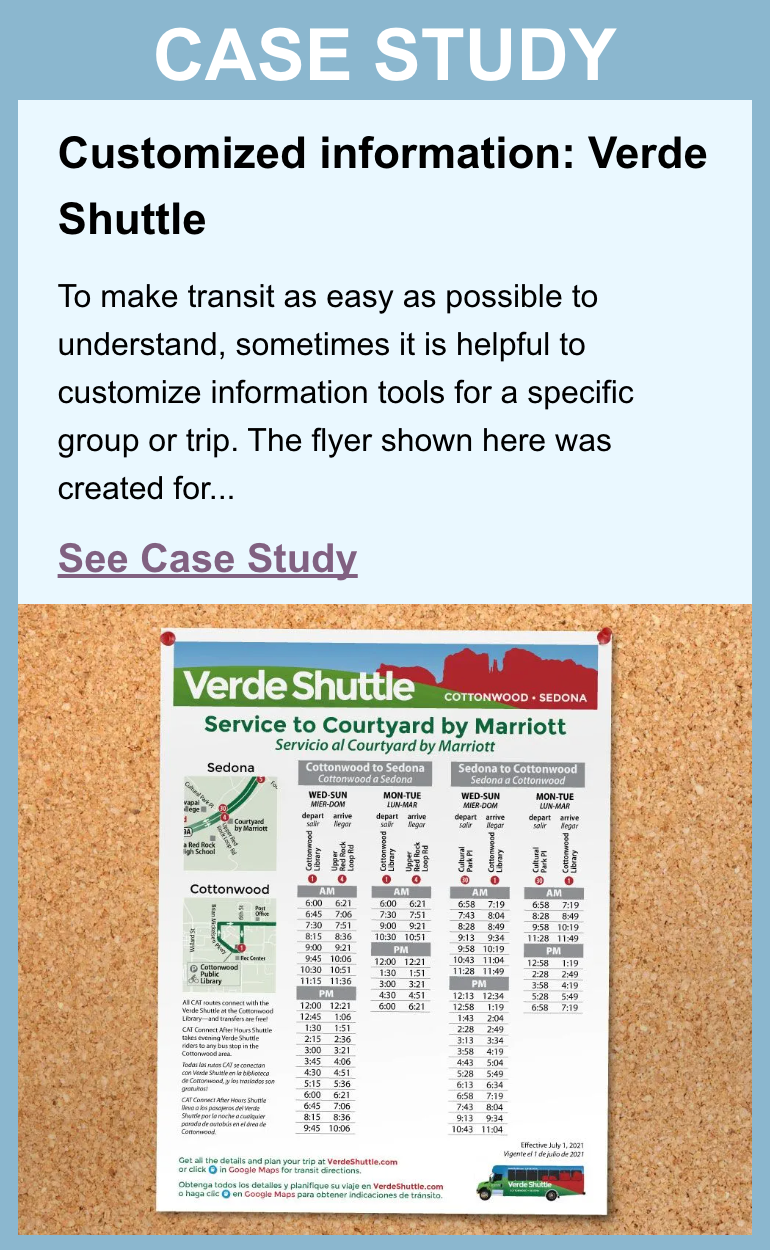Recommended Strategies
Awareness, Image, and Support-Building Recommendations
It is important to build awareness, a positive image, and support among the broad community, including non-riders as well as potential riders.
Effective methods to do this fall into two general categories: non-paid communications channels and paid advertising. This section will describe a variety of ways that you can “get the word out” about your services. Remember, you don’t need to do all of these. Select the strategies that are the best fit for your community, target audience, system, and resources.
Non-Paid Communications Channels
There are many non-paid ways to build visibility and educate the public about your transit system. These include conventional news media, social media, and outreach efforts such as public speaking. While these strategies do not require a budget, they do require staff time to implement.
Internal Channels and Social Media
These days, there are many channels for communicating news about your system and services. These channels can be used together to reach a variety of target groups.
Under “Fundamental Strategies,” we discussed the strategies of creating a news calendar and issuing regular news releases to conventional media–including newspapers, news websites and local broadcast stations. This same news calendar can be used to manage communications through other non-paid channels, including the internal channels you control, free exposure on local media, and social media:
- Website posts
- Email blasts
- Digital newsletter
- Public service announcements
- Social media—Facebook, Instagram, LinkedIn, and/or X (formerly known as Twitter)
- Videos
Use your basic news release to provide content for other communications. For example, if your news calendar included a “stuff-the-bus” holiday food drive, you might use the following communication channels.
- News release about stuff-the-bus event, how to participate, and how the donations will be used
- News post or blog on your website
- Public service announcement about the event distributed to local radio stations
- Facebook post with information about the drive, encouraging your followers to participate and to share the post
- Tweets about location of the bus and hours when donations are being accepted
- Video of event to post on website or Facebook afterwards
- Photos of event to include in a follow-up news release, social media post and digital newsletter article
Update the news calendar periodically to reflect changes and new story ideas. The following are some tips for using recommended channels. Tips for additional channels are included under “Optional Strategies.”
Website Posts and Blogs
News releases that are sent to the news media also can be posted on your website, possibly linked from a “What’s New” or “Blog” button on your home page.
Email Blasts and Newsletters
Check out more information on newsletters and email blasts
here.
Email blasts about important news can be an effective way of communicating with gatekeepers, decision-makers, and riders who have signed up for alerts. You might even consider creating a periodic newsletter that focuses on transit news and features and is distributed to the contacts on your various lists.
Radio Public Service Announcements (PSAs)
Check out the
PSA template.
Radio stations are required by the Federal Communications Commission to serve the public interest. One of the ways they do this is to run public service announcements (PSAs) on behalf of non-profit and government organizations in local communities. Because many organizations submit PSAs, there is a great deal of competition for the limited airtime in which stations play these spots, but it can be worthwhile to send in prepared material if your staff time allows.
While television stations are also required to run PSAs, it’s generally easier to get PSA time on the radio. Spots can be from 10 to 30 seconds. More PSA best practices:
- PSAs are best for precise, time-limited information or to announce something new. Include a URL or phone number for more information.
- Media relations matter. The stronger your relationship with local media staff, the more likely they are to use your PSA. Smaller communities have a great advantage in this regard when they’re served by locally-run radio stations.
Social Media
Almost 90% of Americans use social media, making it a very common communications tool. But it has some significant drawbacks that keep it from being the all-purpose marketing tool it’s sometimes promoted as. It can be difficult for small organizations to build a significant social media presence, meaning that not all followers will see your messages. Additionally, social media requires a meaningful time commitment. You’ll need to set aside time to prepare your messages and post them as well as be ready to respond to viewers’ comments and messages.
Social media best practices:
- Keep content short; link to further information on your site if you have a lot to say.
- Use pictures and videos as much as possible, even if it means just making a simple text-based graphic of your message.
- To understand how successful your page is, track how many followers you have month to month.
- Follow all local community organizations and as many businesses in the service area as possible. Like, comment on, and share their posts, when appropriate.
For more on the basics of social media and rural transit, view the following National RTAP Resources:
The National RTAP Transit Marketing webinars also provide helpful information on social media, especially the
Transit Marketing 101 webinar and
Marketing Workshop #1: Build Awareness.
Your presentations should be tailored to the group you are addressing. For example, if speaking to community leaders, focus on the benefits of transit to the broader community, like creating a mobile workforce, connecting customers with businesses, and serving the needs of those unable to drive. If speaking to human service organization staff, focus on how transit can serve their clients and show them how to use your website or Google Maps to plan trips.
Here are a few tips for maximizing the effectiveness of your presentations:
- PowerPoint makes it easy to customize your presentation. You can create a basic presentation and then tailor it for the audience.
- You also may want to create a customized handout for these presentations. A simple flyer or brochure can be created using one of the templates provided in
The Marketing Toolkit. Like the presentation, the “leave-behind” should provide key facts relevant to the group you are addressing.
- Presentations also provide an opportunity to collect email addresses of audience members so that you can add them to an email newsletter list or invite them to follow you on social media.
Paid Communications Channels
Check out the
marketing and promotions tools section for resources.
If you have budget for advertising and printing, there is a wide variety of promotional channels you can use to build visibility. Some of the most easily used and effective are included under “Recommended Strategies.” Additional advertising channels are included under “Optional Strategies.”
Transit Advertising
Transit advertising is advertising inside buses, on the exterior of vehicles and at bus shelters. One of the beauties of transit advertising is that the space comes free-of-charge; your only expenses are in production costs.
Newspaper
Direct Mail
Event Participation and/or Hosting
Generating Ridership Recommendations (Low and No-Cost)
Options for Building Back Ridership After a Decline
Several of the strategies in
The Marketing Toolkit can help your system build back ridership after a decline such as many transit agencies experienced during and after the COVID-19 pandemic. The transit marketing environment in such a circumstance is not unlike launching a new system: the public needs to be educated on what the service is, how it works, what might have changed (such as safety measures), and its benefits for the unique audiences it serves.
Here are three recommended approaches for rebuilding ridership:
- Partner with the community:
Making connections with the gatekeepers of local organizations that serve your ridership groups is always the most direct path to building ridership. Inform gatekeepers of your service, provide them with passenger information they can distribute to their members, as well as permanent displays of information for their facilities. Provide travel training for their staff. Ask for opportunities to add information to their websites, newsletters, social media, or email blasts. See below for more ideas on how to offer fare programs to community organizations.
- Use paid media to build trial ridership:
If your budget allows, paid media could help build ridership by offering incentives to ride. For example, you can send direct mail postcards with specific route information to people along those routes and include a free-ride offer. You could also consider running newspaper ads with free-ride coupons so people can experience your system at no charge. See below for more ideas on incentives to increase ridership.
- Beef up media relations: Set up a press release calendar and send regular press releases to the local media. This will help raise awareness about your services for the general public, leading to wider support of your service and, potentially, greater ridership.
More Ridership-Generation Recommendations
The more targeted a marketing message is, the more likely it is to create action. A transit system’s most cost-effective opportunity to build ridership is by working through partner organizations in the community to deliver specific messages to populations that can benefit from the transit services provided.
Many organizations serve as gatekeepers for potential transit riders, and can provide access to their constituents. These include social service agencies, schools and youth programs, colleges, employment and training programs, senior centers and residences, medical facilities, and organizations that work with persons with disabilities. If you can identify a group you want to reach, you can probably find an organization willing to partner with you in that effort.
These organizations can give you access to an array of low- and no-cost marketing channels which will allow you to deliver very targeted messages to their clients, students, customers, and employees. Here are several examples of how you might work through gatekeepers to market transit.
Permanent Information Displays
Check out the
Other Resources page for links to companies providing display fixtures.
Customized Information (Audience-Specific)
Newsletter Articles
Many gatekeepers publish email or hard copy newsletters and can include articles about transit services that are relevant to their constituents. Ask them if this is possible and then provide them with draft articles or news releases on a regular basis.
Travel Training
Gatekeepers can offer opportunities to conduct transit travel training with their constituents.
Travel training can take several forms. It can be approached casually, as a group presentation. Opportunities for a casual group travel training might include:
- TANF or other social service program classes
- College student orientation
- Senior nutrition program presentation
In this instance, the training might consist of a PowerPoint presentation, followed by a short on-bus experience or one-on-one personal trip-planning assistance. You may want to provide participants with a free ticket to encourage them to make their first solo trip.
Travel training also can be conducted by peer volunteers. For example, a Bus Buddy program can pair trained older adult volunteers with new riders to take them on their first bus trip, providing travel training along the way.
Travel training can also be more formal, such as a comprehensive one-on-one program for persons with special needs—those with developmental disabilities, sight impairment, or the need to use a wheelchair or other mobility device.
Because it takes the guesswork—and the apprehension—out of riding the bus for the first time, travel training can be a powerful tool for generating ridership.
Some gatekeepers provide transit travel training for their own constituents. You can support these efforts by providing gatekeepers with customized information, a video or PowerPoint to use in their presentations, and/or free tickets to use when training riders. The National Aging and Disability Transportation Center has helpful resources on travel training
here.
